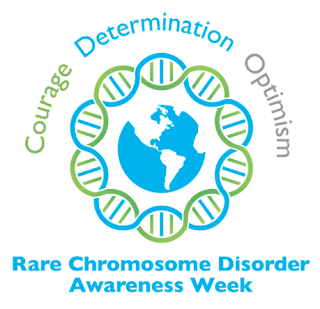I hadn’t given much thought to chromosome disorders. I knew they existed, but I hadn’t delved much into their causes or various manifestations. When our second child was born, tiny but perfect, it didn’t occur to me that there could be something unusual lurking amid the tangle of her DNA.
It wasn’t until our daughter was eight months old that concerns about her atypical development were confirmed. She had stopped feeding and was losing weight, there were some unusual physical traits, and the traditional milestones she was supposed to have achieved had not been met.
After months of struggling to find help (doctors who saw Avery claimed she was fine and that we worried too much), the chromosome test results requested by our family doctor, our sole champion, came in.
Avery was diagnosed with a rare chromosome disorder. And so there it was—our family’s new reality. Despite our suspicions, we were shocked and afraid, sad and confused by it all.
Avery’s disorder affects two chromosomes—chromosomes 3 and 9. “Our bodies are made up of trillions of cells. Most of the cells contain a set of around 20,000 different genes carrying information that tells the body how to develop, grow and function. Genes are carried on structures called chromosomes.
Chromosomes usually come in pairs, one chromosome from each parent. Of the 46 chromosomes, two are a pair of sex chromosomes: (two Xs for a girl and an X and a Y for a boy). The remaining 44 chromosomes are grouped into 22 pairs and are numbered 1 to 22.
A sperm cell from the father and an egg cell from the mother each carries just one copy of each chromosome. When they join together they form a single cell that now carries two copies of each chromosome. This cell must make many copies of itself (and all the chromosomes and genetic material) in order to make all of the many cells that form during human growth and development. Sometimes during the formation of the egg or sperm cells or during this complicated copying and
replication process, parts of the chromosomes can break off or become arranged differently from usual.” source
Avery has a 3p25 deletion which means she has one “normal” intact chromosome 3, but DNA has been lost from the end of the second chromosome 3.
To make matters more complicated, chromosome 9 has also been affected. In plain English, during the initial copying process, a portion of chromosome 3 broke off. In its place a section of one chromosome 9 made a duplicate copy of itself, which then attached itself to the damaged end of chromosome 3.
Mind boggling, isn’t it? Welcome to the wild world of genetics. I never imagined I’d ever know so much about the human genotype. I only took high school biology as an elective because the teacher was cute and it fit perfectly into my timetable.
Our introduction to rare chromosome disorders seems like a lifetime ago. The reality is, though many of the specific disorders are rare, the occurrence of genetic mutations and our awareness of them is not. At least not anymore.
Our global community is so much smaller now with medical information just a click away. Websites like chromodisorderoutreach.org connect and educate families like mine. We don’t feel alone because we know we are not. And that fact alone is a reason for celebration.
Happy Rare Chromosome Disorder Awareness Week! 🙂






